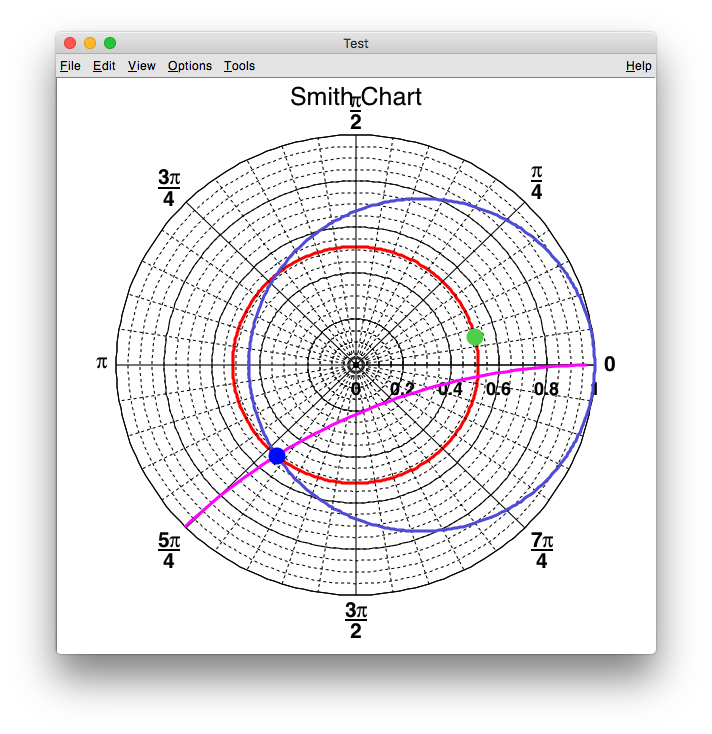If you would like to know not only the Z(DUT) but also the radiation impedance of your antenna, you must go around toward load (counter clockwise rotation) on the Smith chart according to the length and the velocity factor of your cable.
In the figure, the blue dot shows the Z(DUT), and the green one the radiation impedance.
freq1=7.02687 MHz, freq2=7.02978 MHz amp(v2/v1)=0.778415, phase(v2/v1)=-0.53185 rad v1=(1,0i), v2=(0.670893,-0.394757i), v3=(1.32911,0.394757i) z=(0.382788,-0.410701i), z50=(19.1394,-20.535i) gamma=(-0.329107,-0.394757i), abs=0.51395, arg=-129.818 deg vswr=3.1148 cable_length=20 m, velocity_factor=0.67 , phase_toward_load=143 deg
// file name = mytest46.cc
{
ifstream finput("owondata.txt");
Int_t iskip=8;
std::string s;
for(Int_t i=0;i<iskip;i++) {
getline(finput, s);
}
const Int_t icount_max=8192;
Int_t icount=0;
Double_t dummy, data1[icount_max], data2[icount_max], data3[icount_max];
while(icount < icount_max) {
finput >> data1[icount] >> dummy >> data2[icount] >> data3[icount];
if(finput.eof()) break;
icount++;
}
TCanvas *c1 = new TCanvas("c1","Test",0,0,800,600);
TGraph *g = new TGraph(icount, data1, data2);
g->SetMarkerStyle( 20 );
g->SetMarkerSize( 0.5 );
g->Draw("AP");
TF1 *f1 = new TF1("f1", "[0]*sin([1]*x+[2])-[3]");
f1->SetParameter(0, 2000.0);
f1->SetParameter(1, 0.022);
f1->SetParameter(2, 0.0);
f1->SetParameter(3, 0.0);
f1->SetLineColor(kRed);
g->Fit(f1);
TGraph *h = new TGraph(icount, data1, data3);
h->SetMarkerStyle( 24 );
h->SetMarkerSize( 0.5 );
h->Draw("P");
TF1 *f2 = new TF1("f2", "[0]*sin([1]*x+[2])-[3]");
f2->SetParameter(0, 2000.0);
f2->SetParameter(1, 0.022);
f2->SetParameter(2, 0.0);
f2->SetParameter(3, 0.0);
f2->SetLineColor(kYellow);
h->Fit(f2);
Double_t freq1, freq2;
const Double_t fsample = 2000.0; // MHz (interpolated)
freq1 = fsample / ( 2.0*TMath::Pi() / f1->GetParameter(1) );
freq2 = fsample / ( 2.0*TMath::Pi() / f2->GetParameter(1) );
std::cout << "freq1=" << freq1 << " MHz, freq2=" << freq2 << " MHz" << std::endl;
Double_t amp, phase;
amp = f2->GetParameter(0) / f1->GetParameter(0);
phase = f2->GetParameter(2) - f1->GetParameter(2);
std::cout << "amp(v2/v1)=" << amp << ", phase(v2/v1)=" << phase << " rad" << std::endl;
TComplex v1, v2, v3, Z, z50;
v1 = TComplex(1.0, 0.0);
v2 = TComplex( amp*TMath::Cos(phase), amp*TMath::Sin(phase) );
v3 = 2.0*v1 - v2;
z = v2/v3;
z50 = 50.0*z;
std::cout << "v1=" << v1 << ", v2=" << v2 << ", v3=" << v3 << std::endl;
std::cout << "z=" << z << ", z50=" << z50 << std::endl;
TComplex gg;
Double_t gg_rho, gg_theta, vswr;
gg = (z-1.0)/(z+1.0);
vswr = (1.0+TComplex::Abs(gg)) / (1.0-TComplex::Abs(gg));
std::cout << "gamma=" << gg
<< ", abs=" << gg.Rho()
<< ", arg=" << gg.Theta()*360.0/(2.0*TMath::Pi()) << " deg" << std::endl;
std::cout << "vswr=" << vswr << std::endl;
TCanvas * CPol = new TCanvas("CPol", "Test", 900, 0, 600, 600);
const Int_t ncircle = 36000;
Double_t radius[ncircle];
Double_t theta [ncircle];
for (Int_t i=0; i<ncircle; i++) {
radius[i] = gg.Rho();
theta [i] = TMath::Pi()*2.0*(Double_t)i/(Double_t)(ncircle-1);
}
Double_t radius_r[ncircle];
Double_t theta_r [ncircle];
Double_t r_center = z.Re() / (z.Re()+1.0);
Double_t r_radius = 1.0 / (z.Re()+1.0);
for (Int_t i=0; i<ncircle; i++) {
Double_t th = TMath::Pi()*2.0*(Double_t)i/(Double_t)(ncircle-1);
Double_t re = r_center + r_radius*TMath::Cos(th);
Double_t im = r_radius*TMath::Sin(th);
TComplex ww = TComplex(re, im);
radius_r[i] = ww.Rho ();
theta_r [i] = ww.Theta();
}
Double_t radius_x[ncircle];
Double_t theta_x [ncircle];
TComplex x_center = TComplex(1.0, 1.0/z.Im());
Double_t x_radius = 1.0/ z.Im();
for (Int_t i=0; i<ncircle; i++) {
Double_t th = TMath::Pi()*2.0*(Double_t)i/(Double_t)(ncircle-1);
Double_t re = x_center.Re() + x_radius*TMath::Cos(th);
Double_t im = x_center.Im() + x_radius*TMath::Sin(th);
TComplex ww = TComplex(re, im);
radius_x[i] = ww.Rho ();
theta_x [i] = ww.Theta();
}
TGraphPolar * grP1 = new TGraphPolar(ncircle, theta, radius);
grP1->SetTitle("Smith Chart");
grP1->SetMarkerStyle(20);
grP1->SetMarkerSize(2.0);
grP1->SetMarkerColor(4);
grP1->SetLineColor(2);
grP1->SetLineWidth(3);
grP1->Draw("C");
CPol->Update();
grP1->GetPolargram()->SetToRadian();
grP1->GetPolargram()->SetRangeRadial(0,1);
TGraphPolar * grP2 = new TGraphPolar(ncircle, theta_r, radius_r);
grP2->SetMarkerStyle(20);
grP2->SetMarkerSize(2.0);
grP2->SetMarkerColor(4);
grP2->SetLineColor(9);
grP2->SetLineWidth(3);
grP2->Draw("C");
TGraphPolar * grP3 = new TGraphPolar(ncircle, theta_x, radius_x);
grP3->SetMarkerStyle(20);
grP3->SetMarkerSize(2.0);
grP3->SetMarkerColor(4);
grP3->SetLineColor(6);
grP3->SetLineWidth(3);
grP3->Draw("C");
TMarker *m0 = new TMarker(gg.Re(), gg.Im(), 20);
m0->SetMarkerSize(2.0);
m0->SetMarkerColor(4);
m0->Draw();
Double_t freq = (freq1+freq2)/2.0; // MHz
Double_t cable_length = 20.0; // meter
Double_t velocity_factor = 0.67;
Double_t wave_length = velocity_factor * (300.0 / freq);
Double_t phase_toward_load = 2.0 * 2.0 * TMath::Pi() * (cable_length / wave_length);
std::cout << "cable_length=" << cable_length
<< " m, velocity_factor=" << velocity_factor
<< " , phase_toward_load=" << (Int_t) ( phase_toward_load * 360.0 / (2.0*TMath::Pi()) ) % 360
<< " deg" << std::endl;
TComplex gg_toward_load = gg * TComplex::Exp(TComplex(0.0, phase_toward_load));
TMarker *m1 = new TMarker(gg_toward_load.Re(), gg_toward_load.Im(), 20);
m1->SetMarkerSize(2.0);
m1->SetMarkerColor(8);
m1->Draw();
}

